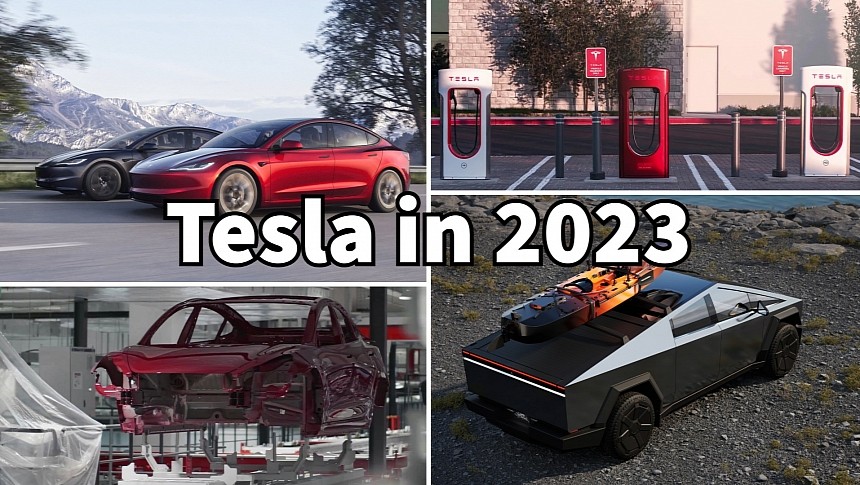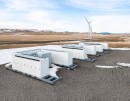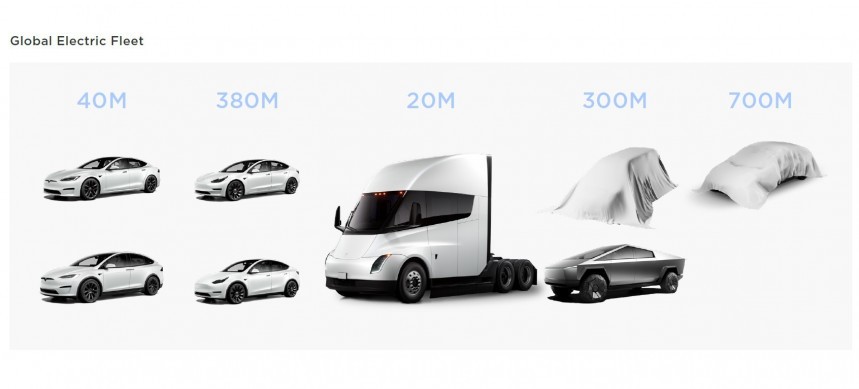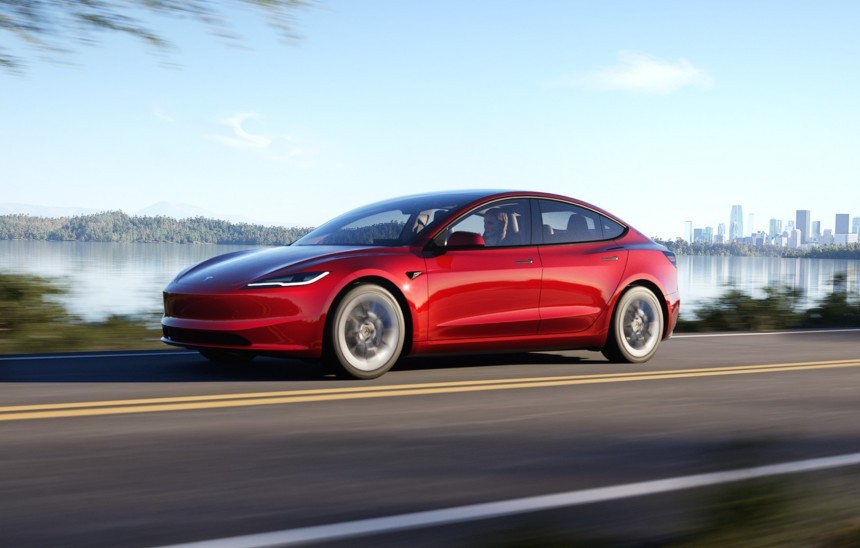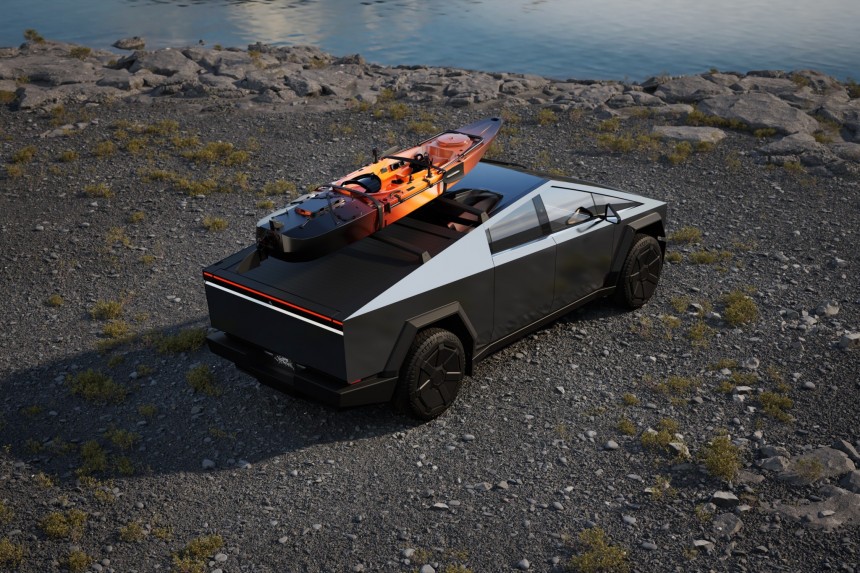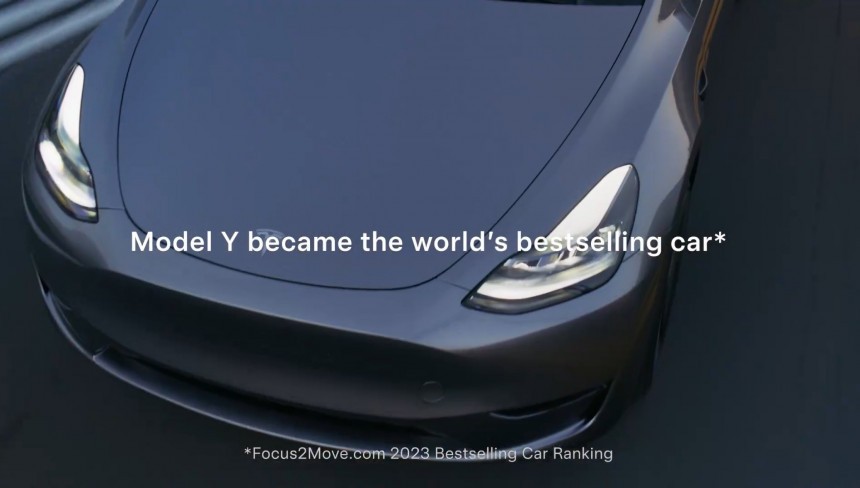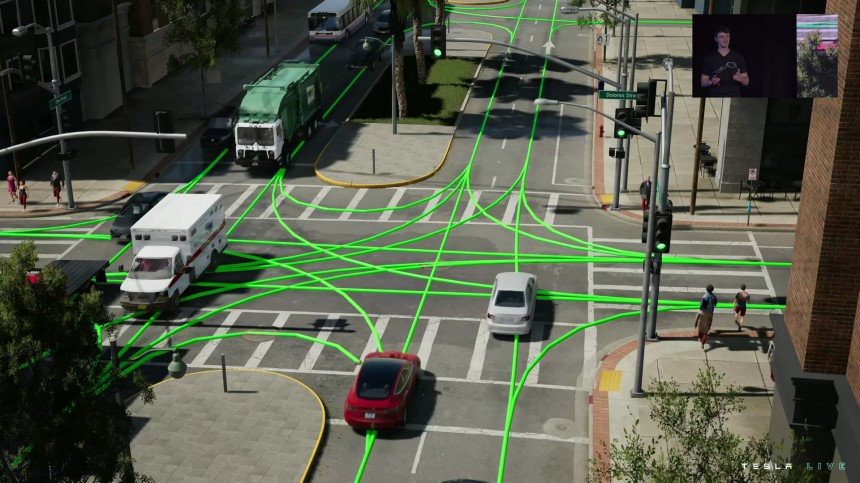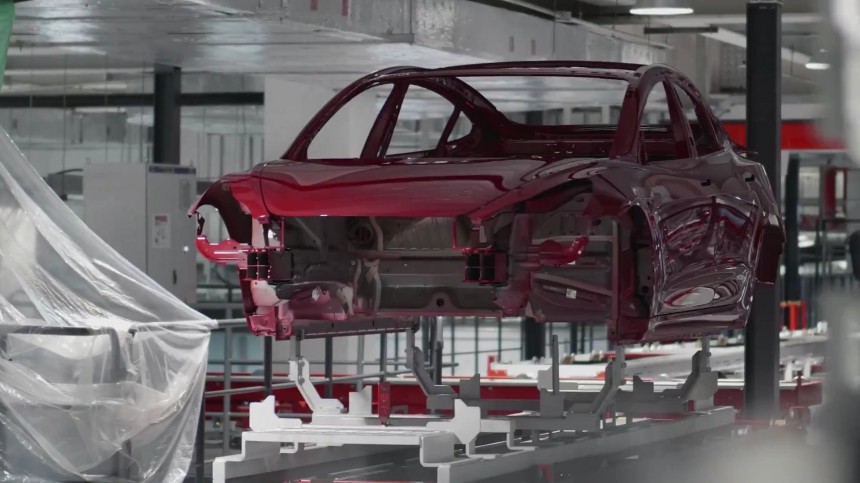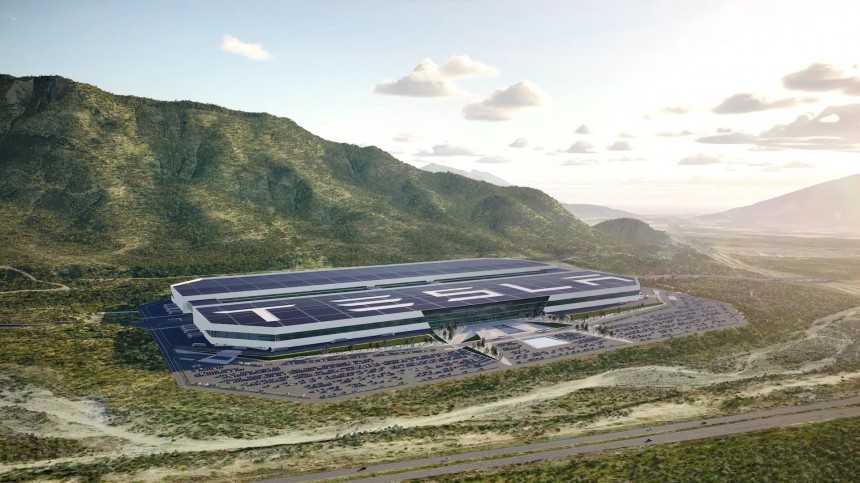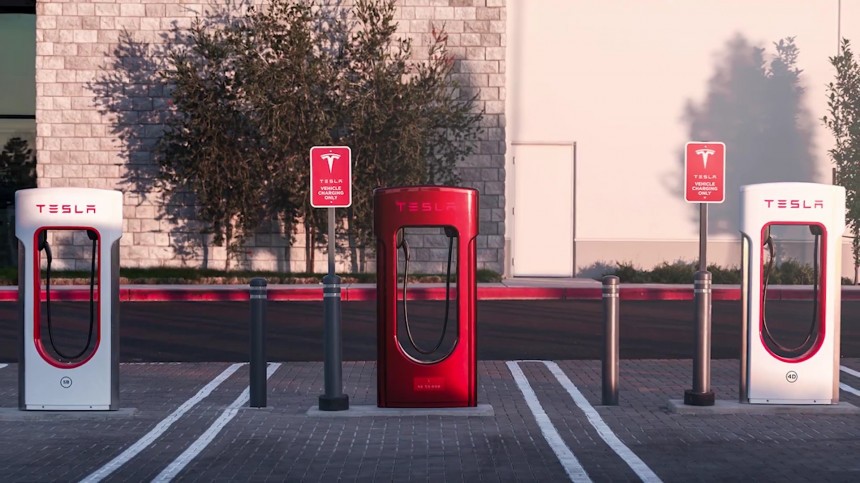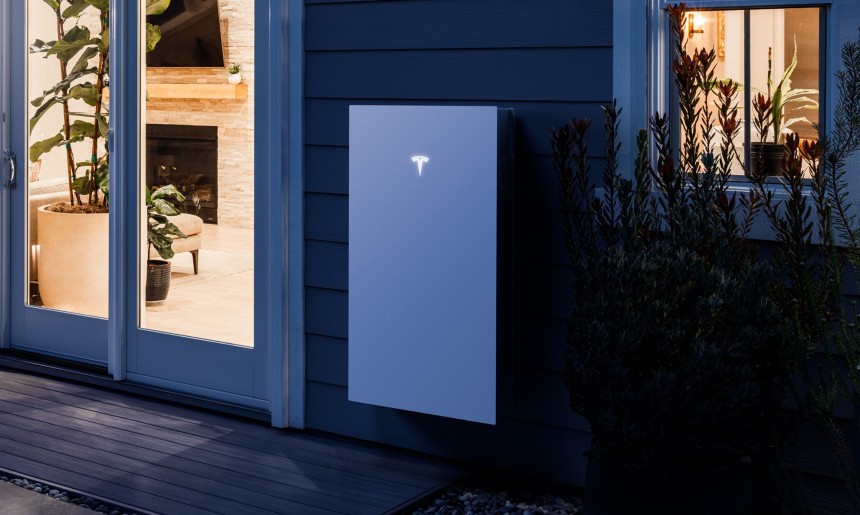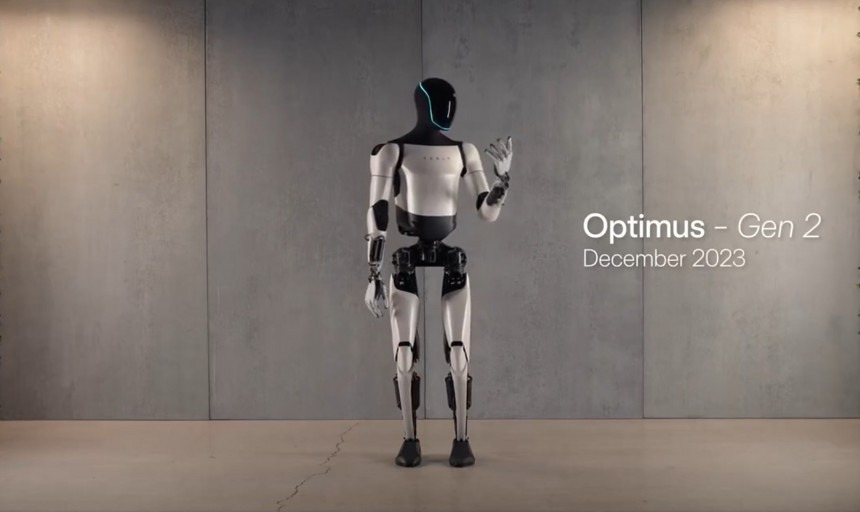Even Tesla's die-hard fans know that Elon Musk has proven overly optimistic when it comes to setting deadlines and delivering new products. His famous "in two weeks" line is a direct consequence of this approach. However, 2023 was the outlier in a long line of years when Tesla failed to meet its deadlines.
Tesla embarked on a mission to change the world for the better, and Elon Musk made this clear in three manifests called "master plans." These master plans have become more ambitious over the years, to the point that few people see Tesla getting through to the other side. This is probably why many still consider it a car company. After all, the original Master Plan unveiled in 2006 was all about making electric vehicles, and it's the only one that has been completed as promised.
In Master Plan Part Deux, presented ten years later, Elon Musk set up additional objectives, which some saw as a distraction from the original goal. However, the second master plan lays out the strategy to move humanity away from fossil fuels and become sustainable.
Everything that Tesla did after that was executing on this master plan, and that includes diversifying its lines of business. Energy generation and storage were added to the mix, while EV production was projected to expand in all major market segments. Then, Musk envisioned autonomous driving and robotaxis as a way to make the roads safer and less cluttered.
We're still far from achieving every objective in the Master Plan Part Deux, although vehicle autonomy and even robotaxis appear to be within grasp. Expanding the Tesla lineup in all market segments is also behind the plan, with the Tesla Semi still not mass-produced and the next-generation platform in development. To complicate things further, Elon Musk outlined the third Master Plan.
This is so complex that Musk needed a 41-page document to explain it. I already covered this in an earlier article, so I'll just say that this is not a plan for Tesla anymore, it's a plan for humanity as a whole. Tesla continues to do its part, but its strategy appears to be to continue working on completing Master Plan Part Deux.
However ambitious this is, as I said, some people are more focused on the noise rather than actual accomplishments. Many objectives and deadlines Tesla and Elon Musk have set have been too optimistic. The modern people of the fast food society are far from patient, and everything that doesn't happen quickly enough to fit their short attention span might as well never happen.
This is why some technologies and products that Tesla has been working on relentlessly for the past years were thought never to materialize. The best and most recent example is the Cybertruck, which was finally delivered to its first customers in late 2023. Full Self-Driving is another area where Tesla over-promised and under-delivered, making some skeptics swear it would never work.
Those who don't believe Tesla will finally nail vehicle autonomy and robotaxis to conclude Master Plan Part Deux should remember that they were skeptical about every Tesla model and technology in the past, only to be repeatedly proven wrong. Tesla might have missed deadlines almost every time before, but in 2023, it ticked some of the boxes as promised, making it an almost perfect year. Here's everything that Tesla achieved last year.
That might have been an understated achievement, but it's been, nonetheless, Tesla's most significant overhaul of an existing model. Until now, the Model S and Model X have seen mild refreshes, new technological additions, and even cabin overhauls. However, the OG Model S still looks mostly the same as the current-production sedan. This might look good for those who bought one, but less flattering for the latest and greatest, despite the technological advancements.
With the Model 3 Highland, Tesla showed that it's not afraid to change things at a more fundamental level. The design evolution has been mostly appreciated, and the technologies and convenience features baked into the refreshed Model 3 are projected to offer the former bestseller a nice sales boost. The Model 3 refresh is all the more critical because the Model Y will also benefit, with a similar overhaul planned for 2024. That should make it more attractive at a time when the competition is getting fiercer.
Sure, the world was on lockdown, causing the car industry to grind to a halt because the supply chain broke, and the microchips disappeared from the market. But even without the pandemic and the madness that ensued, the Cybertruck was complex enough to choke Tesla all on itself. Thankfully, this didn't happen because Musk's company is now in much better shape than it was in 2008 or 2018. But the Cybertruck remained a tough nut to crack.
The electric pickup might have been late to the market, with disappointing characteristics and a higher-than-expected price. However, it's filled to the brim with new and untested tech that is enough to keep it relevant for decades. Even if it fails (although it doesn't appear so), the Cybertruck will pave the way for Tesla's future models to succeed. Think of it as an outlandish test bed that will pay off in the next five years, whether it's a resounding success or a total failure.
Based on its Monroney sticker, the Cybertruck has all it needs to round off the Top 5 in 2024. Tesla's electric pickup has 90% North American parts, with 65% of them coming from the US and Canada and 25% from Mexico. The final assembly, as well as the assembly of motors and gearbox/transmission (legacy designation, as the Cybertruck doesn't feature any), also takes place in Austin, Texas.
What Musk actually said was that the Model Y would become the world's top-grossing vehicle in 2022 and possibly even lead by the number of units sold in 2023. As incredible as this might sound, the Model Y did bring the most revenue of all models in 2022 and was crowned as the world's bestselling car in 2023. According to Focus2Move 2023 Bestselling Car Ranking, the Model Y sold 1.06 million units through November 2023, dethroning the Toyota Corolla (1.01 million).
Although Musk's objective to achieve vehicle autonomy appears as distant as ever, Tesla did accomplish a crucial milestone in 2023. The 12th version of its Full Self-Driving software was launched, bringing end-to-end AI computing to Tesla EVs. Musk made wild predictions over the years, and cracking self-driving was the one he promised almost every year for as far back as I can remember.
However, last year, he almost delivered on the promise to have V12 ready by the end of the year. Almost because the elusive software suite only got to the Wave1 beta testers, not customers' vehicles. Still, the program is much further ahead with V12 than it was last year with V11. And if you wonder what's with all the hype around FSD V12, it's the fact that the software is capable of learning instead of relying on programmers to tell it what to do in each situation. This is a huge milestone that will pay off sooner rather than later.
The software update led to a pause in the FSD development, same as a similar recall affected FSD Beta V11 at the beginning of 2023. However, Tesla managed the situation much better this time, an achievement that led to the timely launch of FSD V12. This makes me confident that Tesla will end 2024 with vastly improved software, which will allow it to certify FSD in markets outside North America.
Tesla has significantly stepped up its manufacturing game in 2023, with its main factories in Fremont and Shanghai running at capacity and new gigafactories in Germany and Texas reaching the mass production milestone. Tesla brags about producing its 5 millionth EV in 2023, but it should be more like 5.5 million EVs produced by now.
Tesla's Gigafactory in Beijing played a significant role in this success story, and reaching its annual capacity of one million vehicles means it cannot go higher without a new expansion phase. Giga Shanghai is not only Tesla's biggest production hub but also the most efficient, which is why the EV maker prefers to import China-made vehicles into Europe instead of producing them locally. All in all, Tesla fulfilled the promise it made to investors to deliver more than 1.8 million vehicles in 2023, an achievement that looked almost impossible a couple of months ago.
Giga Texas is doing a lot better, thanks to the new models introduced in production. The Cybertruck production will keep Giga Texas busy for the next five years, and the Model Y should also get a boost once Project Juniper (Model Y refresh) starts production. Giga Texas is also the place where Tesla's next-generation EVs will start production, and 2024 should be the year we find out more about Tesla's plans in this area.
Giga Mexico was supposed to be the home ground of Tesla's next-generation electric vehicles, including the robotaxi that would fulfill another goal in the Master Plan Part Deux. However, certifications and approvals took longer than expected, and Tesla changed its strategy. The next-gen EVs, together with their revolutionary unboxed-vehicle manufacturing process, will start at Giga Texas. However, there's no clear sign that Tesla began working on these projects.
Another gigafactory expected to be announced soon might be the one in India. Latest rumors indicate that Tesla might build its production complex in Gujarat, and an official announcement might come by the end of January. This new gigafactory will also produce the next-gen EV model after Giga Texas and Giga Mexico will go live. Tesla expects its most affordable EV to be high-volume, requiring significant production capacity to quench demand.
Even though the Cybertruck uses a more advanced variant of the 4680 cells than the Model Y, Tesla had to stop production to prepare the line for the second generation of the larger battery cells, dubbed Cybercells. Based on the Cybertruck's range and charging performance, the Cybercells might need another generation before they are on par with the current 2170 cells.
Tesla Supercharger is already the biggest charging network on the planet, but Tesla continues to expand it at a rapid pace. Last September, Tesla announced the installation of its 50,000th Supercharger stall and added 5,000 new charging posts in less than four months. That's an average of almost 45 stalls opened every day.
In 2023, Tesla opened 1,322 new sites with a total of 12,030 charging stalls. It also started construction works at another 802 sites, while 574 sites are in the process of acquiring the necessary permits. This pace will likely accelerate in 2024, as Tesla is set to benefit from government incentives to expand its network in many markets.
The way Tesla imposed its proprietary plug as the North American Charging Standard was fast and surprising. What started with GM and Ford spread quickly from carmaker to carmaker, and soon all but Stellantis announced adopting NACS. It was only a matter of time before SAE International, which regulates various industries, announced NACS as an industry standard under the J3400 code.
5. Tesla Energy:500K+ Powerwall installations globally
The Powerwall stationary battery storage reached the third generation, another 2023 milestone. This marks a substantial change, as Tesla switched from ternary batteries to LFP cells. The Powerwall 3 is more compact and has superior capabilities, streamlining installation and cutting down labor and time.
Tesla also expanded its footprint in the industrial battery storage market with its Megapacks. The Megapacks is already a success story, as Tesla announced its second production facility in China. Megafactory Shanghai is set to start production in the second half of 2024, with plans to produce 10,000 Megapack units every year. This represents a 40 GWh capacity for the first phase.
Just one year later, Tesla introduced a partly-functional prototype, but the project really took off in 2023. Tesla Optimus Bot learned impressive tricks over the course of last year solely by learning from humans. However, the most significant milestone was the introduction of the second-generation Tesla Bot in December. This has vastly improved hands, allowing them to manipulate delicate objects and soon (Musk promised) thread a needle.
Of course, the real reason Tesla works on Optimus is not to thread needles or dance. The Optimus Bot will probably replace humans in Tesla factories and, as far-fetched as it might seem, help humans settle on Mars. Tesla also sees it as a hot commodity, assisting people with chores around the house.
In Master Plan Part Deux, presented ten years later, Elon Musk set up additional objectives, which some saw as a distraction from the original goal. However, the second master plan lays out the strategy to move humanity away from fossil fuels and become sustainable.
Everything that Tesla did after that was executing on this master plan, and that includes diversifying its lines of business. Energy generation and storage were added to the mix, while EV production was projected to expand in all major market segments. Then, Musk envisioned autonomous driving and robotaxis as a way to make the roads safer and less cluttered.
We're still far from achieving every objective in the Master Plan Part Deux, although vehicle autonomy and even robotaxis appear to be within grasp. Expanding the Tesla lineup in all market segments is also behind the plan, with the Tesla Semi still not mass-produced and the next-generation platform in development. To complicate things further, Elon Musk outlined the third Master Plan.
However ambitious this is, as I said, some people are more focused on the noise rather than actual accomplishments. Many objectives and deadlines Tesla and Elon Musk have set have been too optimistic. The modern people of the fast food society are far from patient, and everything that doesn't happen quickly enough to fit their short attention span might as well never happen.
This is why some technologies and products that Tesla has been working on relentlessly for the past years were thought never to materialize. The best and most recent example is the Cybertruck, which was finally delivered to its first customers in late 2023. Full Self-Driving is another area where Tesla over-promised and under-delivered, making some skeptics swear it would never work.
Those who don't believe Tesla will finally nail vehicle autonomy and robotaxis to conclude Master Plan Part Deux should remember that they were skeptical about every Tesla model and technology in the past, only to be repeatedly proven wrong. Tesla might have missed deadlines almost every time before, but in 2023, it ticked some of the boxes as promised, making it an almost perfect year. Here's everything that Tesla achieved last year.
1. EV production
Model 3 Highland launched in Europe and AsiaThat might have been an understated achievement, but it's been, nonetheless, Tesla's most significant overhaul of an existing model. Until now, the Model S and Model X have seen mild refreshes, new technological additions, and even cabin overhauls. However, the OG Model S still looks mostly the same as the current-production sedan. This might look good for those who bought one, but less flattering for the latest and greatest, despite the technological advancements.
First Cybertrucks delivered
The Cybertruck was unveiled in late 2019, with plans to start production in 2021. However, the world went crazy in 2020, derailing Tesla's plans. Not that Tesla ever delivered its previous models on time. Every time a new product was pushed into production, Tesla faced what Musk described as "production hell," almost bringing the company to the brink of collapse. However, the Cybertruck was special.Sure, the world was on lockdown, causing the car industry to grind to a halt because the supply chain broke, and the microchips disappeared from the market. But even without the pandemic and the madness that ensued, the Cybertruck was complex enough to choke Tesla all on itself. Thankfully, this didn't happen because Musk's company is now in much better shape than it was in 2008 or 2018. But the Cybertruck remained a tough nut to crack.
The S3XY models are the most American-made cars
Critics may say anything, but Tesla is an American company through and through, with research, development, and production on US soil. This was recognized in 2023 when all Tesla models ranked first in the Cars.com American-made Index. The rankings take into account the final production place, the percentage of US and Canadian parts, countries of origin for all available powertrains, and the use of US manufacturing force.Based on its Monroney sticker, the Cybertruck has all it needs to round off the Top 5 in 2024. Tesla's electric pickup has 90% North American parts, with 65% of them coming from the US and Canada and 25% from Mexico. The final assembly, as well as the assembly of motors and gearbox/transmission (legacy designation, as the Cybertruck doesn't feature any), also takes place in Austin, Texas.
Model Y is the world's bestselling car
This has been long in the making, with Elon Musk predicting it as far back as 2021. Of course, everyone laughed when Musk made this statement. The Model Y was selling at insane prices at the time, and the demand was going through the roof, but becoming the bestselling car in the world? Hard to believe, right?2. Software
FSD V12 launchedAlthough Musk's objective to achieve vehicle autonomy appears as distant as ever, Tesla did accomplish a crucial milestone in 2023. The 12th version of its Full Self-Driving software was launched, bringing end-to-end AI computing to Tesla EVs. Musk made wild predictions over the years, and cracking self-driving was the one he promised almost every year for as far back as I can remember.
However, last year, he almost delivered on the promise to have V12 ready by the end of the year. Almost because the elusive software suite only got to the Wave1 beta testers, not customers' vehicles. Still, the program is much further ahead with V12 than it was last year with V11. And if you wonder what's with all the hype around FSD V12, it's the fact that the software is capable of learning instead of relying on programmers to tell it what to do in each situation. This is a huge milestone that will pay off sooner rather than later.
Autosteer recall
Same as last year, Tesla executed an over-the-air software "recall" affecting its driver assistance systems. In this case, Tesla enhanced its driver monitoring system (DMS) to prevent drivers from abusing the Autosteer system (part of Autopilot). For now, the update affects vehicles with a cabin camera DMS, but a similar change will be introduced for the older cars without a cabin camera.The software update led to a pause in the FSD development, same as a similar recall affected FSD Beta V11 at the beginning of 2023. However, Tesla managed the situation much better this time, an achievement that led to the timely launch of FSD V12. This makes me confident that Tesla will end 2024 with vastly improved software, which will allow it to certify FSD in markets outside North America.
3. Manufacturing
5 millionth Tesla producedTesla has significantly stepped up its manufacturing game in 2023, with its main factories in Fremont and Shanghai running at capacity and new gigafactories in Germany and Texas reaching the mass production milestone. Tesla brags about producing its 5 millionth EV in 2023, but it should be more like 5.5 million EVs produced by now.
Tesla's Gigafactory in Beijing played a significant role in this success story, and reaching its annual capacity of one million vehicles means it cannot go higher without a new expansion phase. Giga Shanghai is not only Tesla's biggest production hub but also the most efficient, which is why the EV maker prefers to import China-made vehicles into Europe instead of producing them locally. All in all, Tesla fulfilled the promise it made to investors to deliver more than 1.8 million vehicles in 2023, an achievement that looked almost impossible a couple of months ago.
5K builds per week at Giga Berlin and Giga Texas
This is a production milestone that marks reaching mass-production level, and both Tesla gigafactories have checked it in 2023. The growth path is still unclear from now on, with Giga Berlin being the most affected. The economic conditions in Europe, with sky-high inflation and war next door, put a brake on EV adoption. This basically froze Giga Berlin production to about 200,000 units per year, although the current annual capacity is above 250,000.New gigafactories: Giga Mexico announced
Even though production at Giga Berlin and Giga Texas appears to have plateaued long before reaching its planned capacity, Tesla is already scouting new locations for future gigafactories. 2023 was the year Tesla announced its first new gigafactory in years. Giga Mexico has not yet broken ground but appears as certain as any other Tesla factory before.Giga Mexico was supposed to be the home ground of Tesla's next-generation electric vehicles, including the robotaxi that would fulfill another goal in the Master Plan Part Deux. However, certifications and approvals took longer than expected, and Tesla changed its strategy. The next-gen EVs, together with their revolutionary unboxed-vehicle manufacturing process, will start at Giga Texas. However, there's no clear sign that Tesla began working on these projects.
20 millionth 4680 battery cell produced
Tesla announced that it produced the 20 millionth 4680 battery cell in 2023, a significant milestone that marks cell production ramp-up at Giga Texas. Tesla is working to expand its existing manufacturing line in preparation for a substantial increase in Cybertruck production. The electric pickup is the only Tesla model that uses 4680 cells at the moment after Tesla discontinued the 4680 Model Y in September.Even though the Cybertruck uses a more advanced variant of the 4680 cells than the Model Y, Tesla had to stop production to prepare the line for the second generation of the larger battery cells, dubbed Cybercells. Based on the Cybertruck's range and charging performance, the Cybercells might need another generation before they are on par with the current 2170 cells.
4. Tesla Supercharger expansion
11K+ new Superchargers stalls, 55K in total worldwideTesla Supercharger is already the biggest charging network on the planet, but Tesla continues to expand it at a rapid pace. Last September, Tesla announced the installation of its 50,000th Supercharger stall and added 5,000 new charging posts in less than four months. That's an average of almost 45 stalls opened every day.
All for NACS, and Tesla Supercharging for all
Tesla gradually opened its Supercharger stations around the globe to all electric vehicles. In most markets, the use of unified charge connectors has made it easier for Tesla to offer Supercharging to third-party electric cars. Things are also changing fast in the US, as the wide adoption of Tesla's plug means that adapters, including the Magic Dock, will no longer be necessary.The way Tesla imposed its proprietary plug as the North American Charging Standard was fast and surprising. What started with GM and Ford spread quickly from carmaker to carmaker, and soon all but Stellantis announced adopting NACS. It was only a matter of time before SAE International, which regulates various industries, announced NACS as an industry standard under the J3400 code.
5. Tesla Energy:500K+ Powerwall installations globally
Tesla Energy division is a direct result of the Master Plan Part Deux provision to integrate energy generation and storage. Tesla solar panels and solar roofs harness the energy from the Sun, while the Powerwalls store it efficiently. Tesla has continuously expanded Powerwall installations, with four new countries added in 2023. Last year, Tesla reported that it completed over 500,000 Powerwall installations.
Tesla also expanded its footprint in the industrial battery storage market with its Megapacks. The Megapacks is already a success story, as Tesla announced its second production facility in China. Megafactory Shanghai is set to start production in the second half of 2024, with plans to produce 10,000 Megapack units every year. This represents a 40 GWh capacity for the first phase.
6. Optimus Gen-2 revealed
What started with a comic moment in 2021 is now a serious endeavor, as Tesla is set to become an AI/robotics company, as Musk said. What Musk meant was that Tesla would earn more from the Tesla Bot and AI software like FSD than it would from selling cars and energy-storage batteries. Many laughed in 2021 at the AI Day when Tesla showed dancers dressed like robots while announcing its robotics ambitions.Of course, the real reason Tesla works on Optimus is not to thread needles or dance. The Optimus Bot will probably replace humans in Tesla factories and, as far-fetched as it might seem, help humans settle on Mars. Tesla also sees it as a hot commodity, assisting people with chores around the house.
Tesla 2023 recap
— Tesla (@Tesla) January 3, 2024
Made possible by the hard work of our amazing teams around the world, and each of our owners & supporters.
Thank you for helping us continue to accelerate the transition to sustainable energy! pic.twitter.com/dD5O35CFbV
